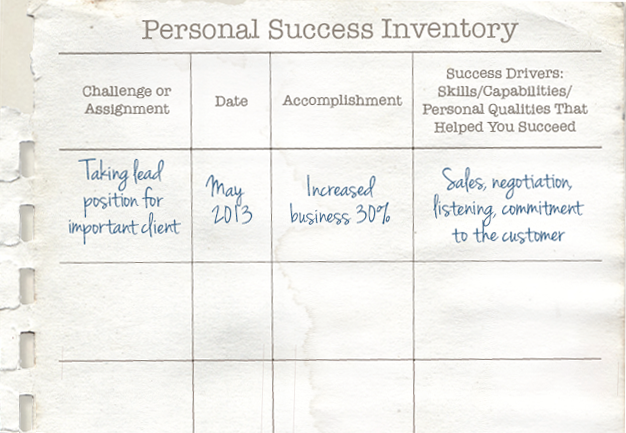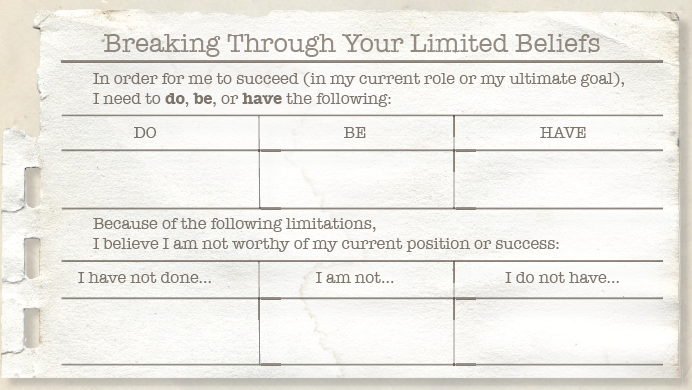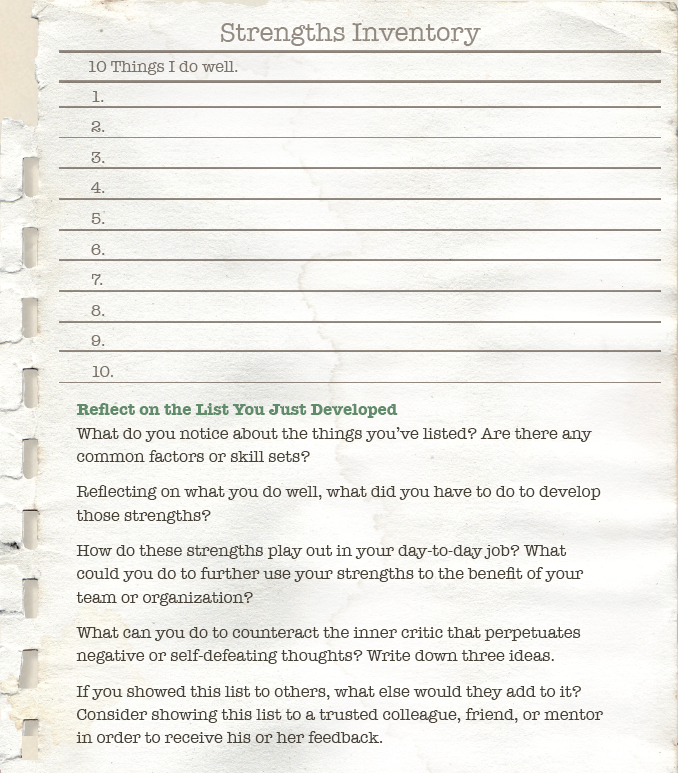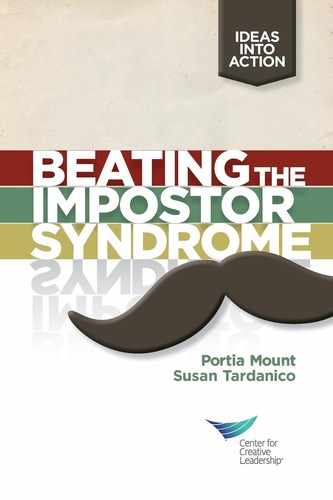Overcoming the Impostor Syndrome
Flawed beliefs about success, failure, and self-worth lie at the root of the Impostor Syndrome. To overcome this debilitating mode of thinking, you need to become aware of inaccurate beliefs that you hold and realign what you believe about yourself and what you experience, observe, and do. These four steps can help:
• focus on facts
• challenge your limiting beliefs
• get clear on your strengths
• talk about it
Let’s look more closely at these actions by using a successful CEO with an enviable track record as an example. We will call him Steve.
Steve’s peers, employees, and customers see him as a smart, intuitive person and respect his views and his actions. Born and raised in Brooklyn by parents of very little means, he was determined to make a better life for himself. Steve attended a local college, obtained a job, rose through the ranks at two public companies, and then started his own company. Five years later, a major financial services company acquired his company, and Steve worked his way up to become CEO of the entire enterprise.
During his stint as CEO, Steve began working with an executive coach. It quickly became evident in their work together that not only was Steve unable to acknowledge his leadership strengths, but he also believed he needed to change who he was to deserve his position. Steve’s feelings of inadequacy stemmed, in part, from his belief that financial means and a pedigreed education equated to intelligent, effective leaders.
He diminished every career success he’d had, saying he was just lucky and that he had people who helped him along the way.
He also believed his Brooklyn accent and distinctive style of communicating was not CEO-like, despite feedback from colleagues and other stakeholders that they loved his refreshingly direct and honest style. In order for Steve to overcome his feelings of inadequacy, his executive coach directed Steve to assess his own skills and performance through a new lens by taking four steps.
Focus on Facts |
Dumb Luck
People who suffer from the Impostor Syndrome often pass off their successes to “dumb luck.” Smart people put themselves in a position to get lucky. And once the “lucky break” takes place, the diligent, resourceful, strategic person capitalizes on it.
Steve’s track record of success (double-digit growth during a recession, high employee engagement, and impressive financial returns) belies his internal limiting beliefs. He sees the world around him through a distorted lens. If asked to explain how he achieved such impressive success, Steve’s stock response is “I’m lucky, and I work harder than everyone else.” Luck and doing whatever it takes may play a part in his success, but Steve needed to see that all of his success can’t be tied to those factors alone. Therefore, the executive coach had Steve conduct a personal success inventory to make the facts about his career visible so that he could focus on them.
Using the Personal Success Inventory worksheet, Steve listed dozens of his major successes and identified the core skills he drew on to achieve them. Steve pressed himself to honestly assess how much of each success was attributable to luck versus specific skills, strategies, and execution. His reflection and analysis showed him that the stories he was telling himself and others about his successes were more myth than reality. Like Steve, you can take steps to separate fact from fiction about your success by completing the following worksheet.
Personal Success Inventory
Do you own your success? Use this worksheet to examine your accomplishments and determine how much of your success was actually due to something other than luck. By conducting an objective assessment of your achievements, you are likely to see a pattern that suggests you applied new skills, approaches, or insights that allowed you to accomplish those goals.
Directions: Complete this worksheet with as many successes as possible. At a minimum, include at least five successes from the past one to three years. The more successes you can list over a longer timeframe, the more insight you can achieve!
If you (or your coach) feel you are unable to objectively conduct this assessment alone, you might want to get a more balanced perspective by soliciting input from colleagues who worked with you on these projects. You may also want to complete a 360-degree feedback assessment in order to gain a clearer picture of your successes.
List your accomplishments in chronological order.

After completing your inventory list, take some time to analyze it and mine for deeper insights. Here are some questions to get you started:
• Observe the chronology of your successes. Did one achievement lead you to another? What specific skills, capabilities, and attributes did you develop through each experience that added to your overall competence?
• From the list, pick your three proudest accomplishments and describe three specific things you did to achieve each goal. The more detailed your description, the better. Write your description in a very objective and straightforward way, as if you’re a newspaper reporter. Be careful not to discount anything because it was “too easy” or “something anyone could have done.”
• In cases where you listed a high percentage of success due to other team members, list what you did to lead the team to success. How did you facilitate the achievement of the goal through other people?
• Refer to your sheet and pick one recent challenge you overcame. What did it look like when you successfully dealt with this challenge? What did you learn about yourself in the process? What specific moments stand out, and how can you replicate them or transfer the lessons you learned to another challenge you face?
Once you’ve thoughtfully answered these questions, step back and consider whether you have truly owned your successes and whether you’ve acknowledged the facts about your achievements. Having a strong self-awareness of your strengths and successes is the first step to overcoming the Impostor Syndrome.
Challenge Your Limiting Beliefs |
Steve believed that his experiences and personality traits were unable to justify his success. After all, successful CEOs have advanced degrees from Ivy League schools, speak with perfect diction and a proper accent, are always poised, and if they had pulled themselves up by their own Herculean efforts, show little or no sign of their hardscrabble roots or modest heritage. This set of limiting beliefs kept Steve in denial about his ability and legitimacy to be a successful CEO.
Steve’s coach gave him an assignment: identify top-performing CEOs who had attended lesser-known colleges or who hadn’t earned a degree at all. In addition, Steve’s coach assigned him to identify several highly successful, respected CEOs who spoke with distinctive regional accents that might be considered outside the norm. As he researched, Steve began to see that his assumptions about CEO success factors were flawed. In fact, he learned that many CEOs he admired had actually overcome similar challenges in life or had some of the same qualities that he had discounted as “not CEO-like.”
When Steve brought the results of his assignment to his next coaching session, his coach used them to explain that attributes such as the ability to earn stakeholder trust, to communicate and inspire vision, and to make quality decisions (all of which were among Steve’s strengths) are far more accurate indicators of effective leadership than those attributes Steve believed were most important.
Steve learned that where leaders attended school, what their early financial conditions were, and what accent they used were largely irrelevant to leadership success.
It’s vital to acknowledge and embrace your capabilities and skills if you suffer from the Impostor Syndrome. A solid awareness of the external facts can often challenge the powerful and limiting beliefs you hold.
See the complete worksheet at the end of the book.
worksheet
Breaking Through Your Limited Beliefs
Like Steve, it’s time for you to break through your limiting beliefs. Complete these three steps.
Identify Your Beliefs about Success
Steve thought that successful CEOs needed to have Ivy League degrees, speak with perfect diction and a proper accent, and come from stable, comfortable backgrounds. What are your beliefs about what you need to do, be, or have in order to succeed?

Go on a Fact Hunt
Consider that your perceived success criteria may not, in fact, be accurate. Do some research and find facts and examples of others with similar attributes (or perceived limitations) who have achieved success in your field. Document these examples.
Reassess Your Beliefs
Armed with the facts, consider that your own limiting beliefs may be your greatest barrier to success. What if these limitations aren’t limitations at all, or not as significant as you’ve assumed they are? Which of your current beliefs may be holding you back?
Get Clear On Your Strengths |
When Steve’s coach asked him what his strengths were, Steve fumbled a bit and eventually said, “I work harder than anyone else.” When pressed for more, he said, “I guess people like working with and for me.” Then, he launched into all the ways he needs to improve to be even more effective in his role, primarily focusing on how to improve his weaknesses.
The coach handed Steve a blank piece of paper and instructed him to write down 20 things he did well. At first, Steve looked like a deer in the headlights, so the coach brainstormed with him to get started. Then, the coach gave Steve five minutes to list his 20 items. This time-bound exercise helped Steve ignore the inner critic that would debate and discount each item before it made it to the page.
For the next two coaching sessions, Steve and his coach went through his list of strengths and talked about how each of them played out in the workplace. They brainstormed how he can use them in even more meaningful ways. By talking in concrete terms about his strengths, Steve came to see that they were real, were valuable, and helped define his leadership.
People who suffer from the Impostor Syndrome often overlook their strengths and instead focus on their weaknesses.
After all, they’re convinced of their incompetence, so what better way to reinforce that belief than to focus on shortcomings? However, research shows many weaknesses occur because leaders are unaware of their strengths. For instance, a leader who believes he or she lacks management skills may try micromanaging to compensate, which creates a whole host of problems. Once this leader sees that he or she does possess good management skills, this can lessen the desire to micromanage, and thus awareness of a strength helps to alleviate a weakness. You can begin to shift your thinking by conducting a strengths inventory and then dedicating time to showcasing and maximizing those strengths.
See the complete worksheet at the end of the book.
worksheet
Strengths Inventory
Set an alarm for five minutes and write down 10 things you do well (e.g., creating strategy, developing others, thinking analytically, leading teams). If you’re having trouble getting started, consider asking a trusted friend or colleague to help you brainstorm.

Talk About It |
The most competent people are good at leveraging the strengths and expertise of others. Asking for help is not a sign of weakness. It is a sign of wisdom.
It’s difficult for sufferers of the Impostor Syndrome to share their feelings of inadequacy with others.
After all, they are afraid of being found out!
Why would they risk exposure and increase their vulnerability? But as with so many emotional and psychological burdens, sharing your feelings and thoughts with someone you trust can greatly reduce stress and strain.
At first, Steve resisted this fourth step, saying that there was no one in his organization he could trust with this kind of information. What if he planted seeds of doubt in those he was leading? Steve’s coach encouraged him to reach out to another CEO, Dave, with whom Steve had forged a relationship during CCL’s Leadership at the Peak program for C-Suite executives. Steve and Dave had agreed to serve as mentors and sounding boards for each other, but Steve had never taken Dave up on it, feeling like his challenges were probably trivial when compared to Dave’s.
Finally, Steve made the call, and the ensuing conversation was the capstone of Steve’s journey in overcoming the Impostor Syndrome. As it turned out, Dave had many of the same thoughts and feelings. Steve was amazed. Dave was an incredibly strong, confident, and successful CEO—how could he be a victim of the Impostor Syndrome? This exchange helped Steve see the folly of his own beliefs, and he and Dave agreed to keep the lines of communication open, serving as confidantes for one another.
Sufferers of the Impostor Syndrome are often shocked to find that people close to them—people they respect—have the very same feelings. This revelation often helps them realize the flaws in their own self-perception. How could someone who is so successful, so talented, and so strong possibly feel this way? It’s crazy! Yes, it is. Sharing with others is the first step toward building a support system that will not only relieve you of your false beliefs but enhance your performance as a leader.
Who can you talk to? Obviously, the answer to this question differs depending on your unique situation. Here are some potential avenues to pursue:
• a peer in another function at your organization/company
• an established mentor
• a peer outside your organization/company who understands the pressures you are under
• an executive coach
• a former boss or colleague from another company
• bloggers and authors who have published on the Impostor Syndrome and have avenues for online chats and community building among imagined impostors

